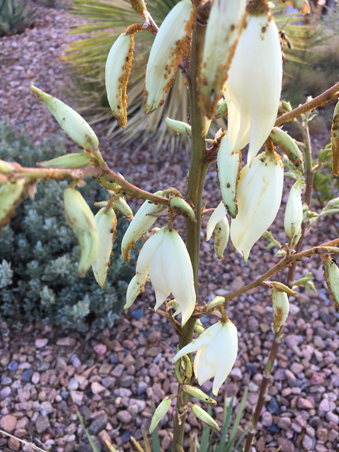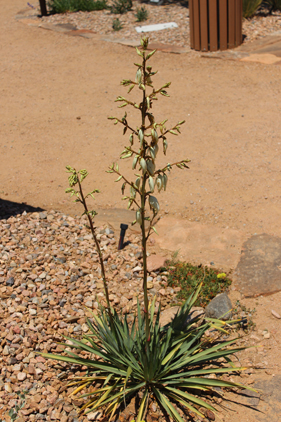The plant w/flowers

The flowers
Description
"Yucca filamentosa[1] is a species of flowering plant in the family Asparagaceae[2] native to the southeastern United Statesfrom southeast Virginia south to Florida, and as far west as south and southeast Texas.[3] They have become naturalized along the coastal plain and beach scrub of the Atlantic Coast north to Long Island Sound and into areas of the lower Midwest.[citation needed] They are normally hardy in USDA hardiness zones of 5 to 9. Most commonly found in sandy soils, especially in beach scrub and dunes, but also in fields, barrens, and rocky slopes, though it grows well also in silt or clay soils. Its common names include Adam's needle, common yucca, Spanish bayonet,[4] bear-grass, needle-palm, silk-grass, and spoon-leaf yucca.[5] The species is also reportedly naturalized in France, Italy and Turkey.[6]
Usually trunkless, it is a multisuckering evergreen shrub with heads of 75 cm (30 in) long, filamentous, blue-green, strappy leaves. It is fully hardy, though in cultivation it benefits from a sheltered position away from winter winds. Y. filamentosa is readily distinguished from other yucca species by white, thready filaments along the leaf margins.[7] Flower stems up to 3 m (10 ft) tall bear masses of pendulous cream flowers in early summer.[3] They are pollinated by the yucca moth Tegeticula yuccasella.[8][9] Other moth species also use this yucca as a host plant to lay their eggs, such as Tegeticula intermedia.[10]
Y. filamentosa is closely related to Yucca flaccida and it is possible they should be classified as a single species.[3]" (Wikipedia)
Ethnobotanical Uses
Food:
"Best-tasting parts: Flower buds, flowers, and young fruits. Raw or cooked. Buds and flowers work well in soups, salads, omelets, kebabs, fritters, or stir-fries. Young fruits can be sliced and fried, baked, stuffed, barbecued, or pickled. Dehydrate to preserve. Seeds may be roasted and ground into flour. Some people report a disagreeable aftertaste and/or laxative effect with this plant." (Seebeck 105)
"The flowers have been eaten raw in salads, cooked in soups, or deep-fried like squash blossoms. It is recommended that their bitter, green centers be removed. The young seed pods were roasted in ashes and eaten, and the ripe fruits were peeled, seeded and baked. They have been used like apples in pies and jams. The leaves are also said to have been boiled with salt and eaten, but they are extremely fibrous." (Kershaw 107)
Recipe: Yucca Flower Veggie Saute
"Peel 1 cup petals off the flower's central core, Bring a pot of water to a boil, and boil flower petals for 15 to 20 minutes. Strain.
In a saucepan heat 1 teaspoon canola oil; add the following chopped vegetables: 1 tomato, 1 onion, 2 cloves garlic, and 1 green pepper. Add the boiled flower petals and 1 teaspoon honey or sugar. Stir to combine. Simmer for 15 minutes, slightly covered. Serve with warm tortillas or corn chips." (Morgan 125)
Medicine:
"Tea made from the roots was given to women in prolonged labor. It was thought to clean the sticky covering from an over-sized baby and speed delivery. Similarly, a cupful of yucca suds sweetened with sugar was given to speed delivery of the afterbirth. Yucca fruit has been reported to induce vomiting, but most sources say it is edible." (Kershaw 107)
"Recent clinical studies have shown it to be of some use in the treatment of joint inflammations but the function is not understood. One-fourth ounce of the inner root should be boiled in a pint of water for fifteen minutes and drunk in three or four doses during the day. Arthritis being such an idiosyncratic disorder, no single treatment will help more than a percentage of people, but if Yucca tea is effective, it can relieve pain for several days afterwards. If a strong laxative effect persists, especially if accompanied by intestinal cramping, decrease the amount next time. ---The tea has some value for urethra or prostate inflammations." (Moore 169-70)(Moore 169-70)
"Blackfoot Decoction of grated roots used for sprains. Decoction of root used as a tonic for falling hair. Poultice of roots applied to inflamed and bleeding cuts. -- Decoction of grated roots used as herbal and sprains. (Ramah) Rotten root used to make suds taken to induce menopause. Cold infusion of root used to expedite delivery of baby or placenta. Compound containing leaf juice used to poison arrows." (Moerman 607)
Other Uses:
"The fibrous leaves were split and used as all-purpose ties, for hanging and drying household items and for weaving loose baskets. Some tribes pounded the leaves in water to release the fibers and then twisted or plaited them to make cord, rope and nets. Narrow slips of leaves were fringed and used as paintbrushes. ---The Navajo pounded the roots with rocks to remove bark and soften the roots and then vigorously stirred the softened mass of fibers in warm water to whip up suds. This soapy mixture was used to wash wool, clothing, hair and the body. It was also said to reduce dandruff and baldness. The Ramah Navaho used the soapy mixture for ceremonial purification baths before weddings and the naming of infants and after burials. The juice of the leaves. boiled alone was used as a red dye." (Kershaw 107)
"The use of yucca fiber for matting and in basketry was and is widespread. Cloth once made from yucca cordage sometimes incorporated fur or feathers in the weave. One of the early excavations of the Frijoles ruins at Bandelier, for example, turned up a delicate blanket composed of rabbit skins combined with yucca fiber. ---Yucca root shampoo is know to give black hair a shiny look prized by ceremonial dancers." (Dunmire and Tierney 126)(Dunmire and Tierney 126)
Recipe: Yucca Shampoo
"Add 1/2 cup yucca root (fresh or dried) to 1 1/2 cups water. Boil until mixture becomes sudsy. Remove from heat, and use as you would any shampoo.
Variation: Can also be made using cold water." (Morgan 125)
"(Navajo, Ramah) Juice mixed with yellow soil for a black dye. Juice alone boiled alone for a red dye." (Moerman 607)
Internet Resources
